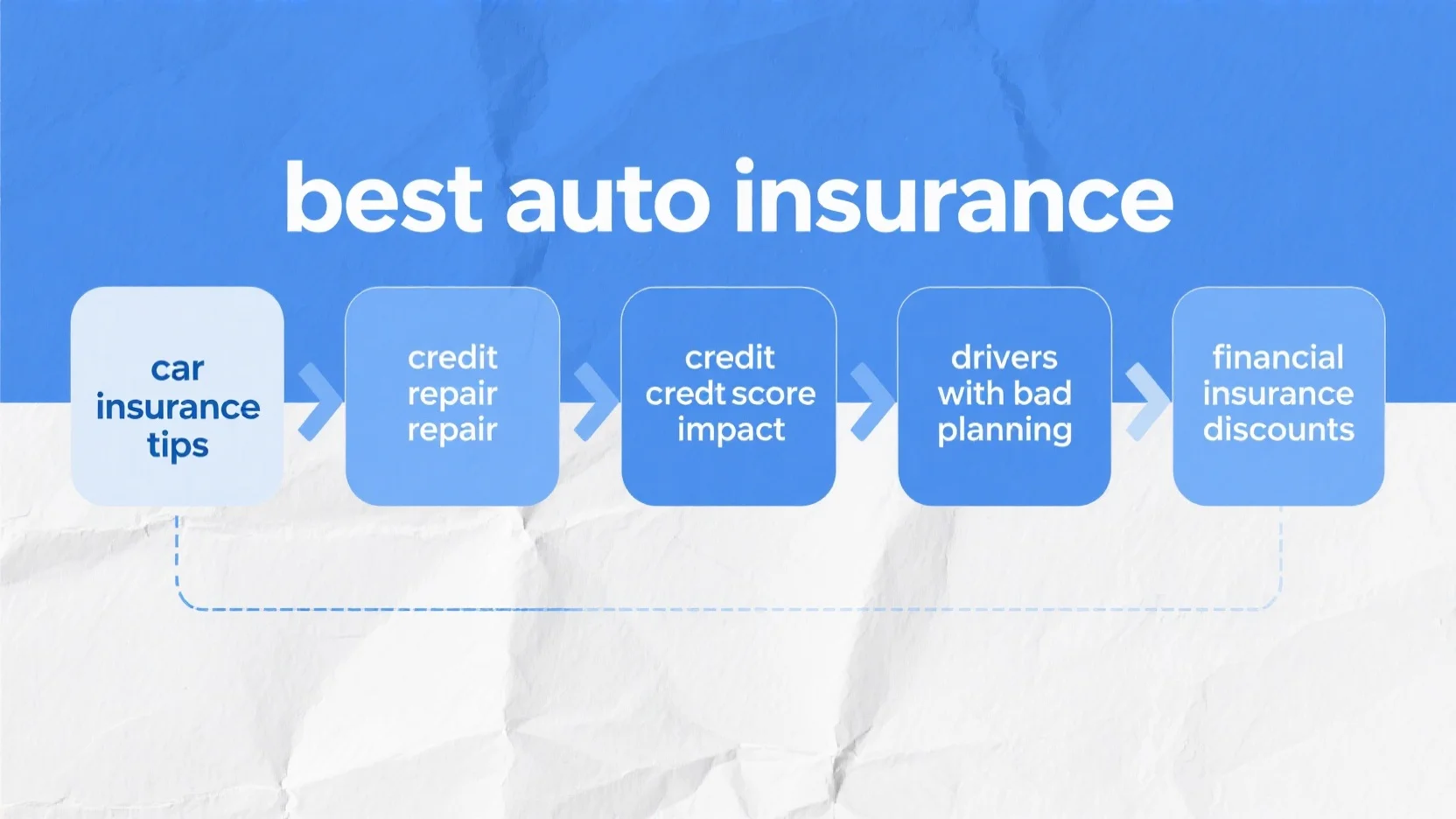
How Drivers with Bad Credit Can Save on Car Insurance

Image Source: pexels
Drivers with bad credit often face higher car insurance premiums. For example, in Michigan, they pay 263% more than those with excellent credit. Nationally, safe drivers with poor credit spend over double the premiums of those with good credit. Finding the best auto insurance for drivers with bad credit requires proactive strategies to reduce costs.
Key Takeaways
- Drivers with poor credit can save by checking different insurance quotes. Comparing prices helps find cheaper options.
- Raising your deductible can make monthly payments smaller. A bigger deductible means paying more if you file a claim, but it can save money overall.
- Better credit scores can lower car insurance costs later. Paying bills on time and using less credit can improve your score.
Why Credit Scores Impact Car Insurance Rates

Image Source: pexels
The connection between credit scores and risk assessment
Insurance companies rely on credit scores to predict risk. Studies consistently show a link between credit scores and the likelihood of filing claims. Here’s what the data reveals:
- Actuarial studies confirm that individuals with higher credit scores file fewer claims.
- Drivers with lower credit-based insurance scores tend to file claims more often.
- Insurers use this information to assess risk and determine premium rates.
This connection helps insurers identify which drivers are more likely to cost them money. While it may seem unrelated to driving ability, credit scores provide a statistical measure of financial responsibility, which insurers believe correlates with risk.
Why insurers charge higher premiums for lower credit scores
Drivers with poor credit often face higher premiums because insurers see them as riskier customers. Several factors contribute to this:
- Historical data shows that drivers with lower credit scores file more claims.
- Claims from these drivers tend to be more expensive for insurance companies.
- Insurers combine credit scores with other factors, like driving history, to calculate rates.
For example, the average premium for someone with very poor credit is $1,667, compared to $470 for those with exceptional credit. That’s a difference of $1,197! This pricing strategy helps insurers offset potential losses from higher-risk drivers.
States where credit scores cannot be used for insurance pricing
Some states have laws that prohibit insurers from using credit scores to set rates. These include:
- California
- Hawaii
- Maryland
- Massachusetts
- Michigan
- Nevada
- Oregon
- Utah
In Massachusetts, for instance, auto insurance companies cannot use credit information when setting rates or renewing policies. States with these bans aim to create fairer pricing systems, ensuring that drivers aren’t penalized for financial challenges unrelated to their driving behavior.
Strategies to Save on Car Insurance with Bad Credit
Shop around and compare quotes from multiple insurers
Drivers with bad credit can save money by comparing quotes from different insurance companies. Rates vary significantly between providers, even for similar coverage. Shopping around allows drivers to find the most affordable option tailored to their needs. Many insurers offer online tools to make this process easier. Comparing at least three quotes can help uncover the best auto insurance for drivers with bad credit.
Increase your deductible to lower monthly premiums
Raising the deductible is another effective way to reduce monthly premiums. A higher deductible means the policyholder agrees to pay more out-of-pocket in the event of a claim. This shift in financial responsibility often results in lower premiums.
- Increasing the deductible can lead to significant savings.
- For example, opting for a $1,000 deductible instead of $500 can reduce premiums noticeably.
However, drivers should ensure they can afford the higher deductible if an accident occurs.
Bundle car insurance with other policies for discounts
Bundling insurance policies can lead to substantial savings. Many companies offer discounts when drivers combine auto insurance with home, renters, or life insurance.
- Progressive reports that bundling can save customers over 20% on average.
- State Farm estimates annual savings of $1,073 for bundled policies.
| Provider | Bundling Discount | Notes |
|---|---|---|
| Amica | Up to 30% | Significant discounts for drivers with bad credit |
| Geico | Not specified | Offers discounts for bundling multiple vehicles |
Drivers should ask their insurer about bundling options to maximize savings.
Ask about discounts for safe driving, low mileage, or other factors
Insurance companies often provide discounts for safe driving habits or low mileage. For instance, drivers who log fewer than 10,000 miles annually may qualify for low-mileage discounts.
- Low-mileage discounts: Savings for driving less than a specified mileage.
- Usage-based discounts: Reduced rates based on driving behavior tracked through telematics.
- Mileage-based policies: Premiums calculated using a base price plus a per-mile charge.
Safe drivers can also benefit from programs that reward accident-free records or defensive driving courses.
Consider usage-based or pay-per-mile insurance options
Usage-based or pay-per-mile insurance can be a game-changer for low-mileage drivers. These plans calculate premiums based on actual driving habits or miles driven.
| Benefit/Limitations | Description |
|---|---|
| Cost Savings | Pay-per-mile insurance can lower costs for drivers who don’t drive often. |
| Target Audience | Ideal for retirees, remote workers, and students living near campus. |
| Not Suitable | High-mileage drivers may not benefit from this model. |
Nationwide’s SmartMiles and Allstate’s Milewise programs are excellent options for drivers with bad credit. These plans can save up to 30% compared to traditional insurance.
Best Auto Insurance for Drivers with Bad Credit
Companies known for competitive rates for drivers with bad credit
Finding the best auto insurance for drivers with bad credit can feel overwhelming, but some companies stand out for their competitive rates and unique features. Here’s a quick comparison:
| Insurance Company | Average Rate for Poor Credit | J.D. Power Satisfaction Rating | A.M. Best Rating | Standout Features |
|---|---|---|---|---|
| Geico | $2,447 | Below average | A++ | Low average rates, available nationwide, multiple discounts |
| Amica | $2,861 | Above average | A+ | High customer satisfaction, bundling discounts up to 30% |
| First Acceptance | N/A | N/A | C++ | Specializes in high-risk drivers, flexible payment schedules |
| Dairyland | N/A | N/A | A+ | Coverage for motorcycles, non-owner policies |
| Nationwide | N/A | Lower than average | N/A | SmartRide program for safe driving discounts |
Geico offers some of the lowest average rates, while Amica excels in customer satisfaction. First Acceptance and Dairyland cater to high-risk drivers, making them solid options for those with bad credit.
Features to look for in an insurance provider
Drivers with bad credit should focus on providers offering flexibility and discounts. Look for companies that specialize in high-risk drivers or provide usage-based insurance programs. Discounts for bundling policies or safe driving can also help reduce costs.
Additionally, consider insurers with flexible payment plans. Companies like First Acceptance allow drivers to customize payment schedules, which can ease financial strain. Nationwide’s SmartRide program rewards safe driving habits, making it a great choice for those looking to save.
How to evaluate customer reviews and ratings
Customer reviews and ratings can reveal a lot about an insurer’s reliability. Start by checking J.D. Power satisfaction scores, which measure customer experiences. A.M. Best ratings assess financial stability, ensuring the company can handle claims.
Online reviews can also provide insights into customer service and claims processing. Look for patterns in feedback. For example, consistent complaints about delays might indicate poor service. Comparing reviews across multiple platforms can help drivers choose the best auto insurance for drivers with bad credit.
Tip: Don’t just focus on price. A company with slightly higher premiums but excellent service might save you headaches in the long run.
Improving Credit to Lower Insurance Costs
Steps to improve your credit score over time
Improving a credit score takes time, but small, consistent actions can make a big difference. Paying bills on time is one of the most effective ways to boost credit. Setting up automatic payments or reminders can help avoid missed deadlines. Reducing credit card balances also improves credit utilization, which is a key factor in credit scoring. Experts recommend keeping utilization below 30% of the credit limit.
It’s important to understand how different actions affect credit recovery. For example, missing a payment can take up to 18 months to recover from, while bankruptcy may impact credit for over six years. The table below highlights how long it typically takes to see improvements:
| Action | Avg. Recovery Time | Credit Score Impact |
|---|---|---|
| Applying for Credit | 3 months | Minor |
| Closing an Account | 3 months | Minor |
| Maxing Out a Credit Card | 3 months | Moderate |
| Missed Payment / Default | 18 months | Significant |
| Bankruptcy | 6+ years | Significant |
By focusing on positive habits, drivers can gradually rebuild their credit and improve their financial health.
How better credit can lead to lower premiums
Better credit doesn’t just open doors to loans and credit cards. It also leads to lower car insurance premiums. Insurers view drivers with higher credit scores as less risky, which often results in significant savings. For instance, someone with excellent credit might pay hundreds less annually compared to a driver with poor credit. Improving credit can also unlock additional discounts, such as bundling or safe driving rewards. Over time, these savings add up, making better credit a smart financial goal.
Resources for credit repair and financial education
Drivers looking to repair their credit can access many helpful resources. Nonprofit organizations like the National Foundation for Credit Counseling (NFCC) offer free or low-cost credit counseling. Online tools, such as Credit Karma or Experian Boost, provide insights into credit scores and tips for improvement. For those needing more guidance, financial literacy courses can teach budgeting, debt management, and credit-building strategies. These resources empower individuals to take control of their finances and work toward long-term stability.
Tip: Start small. Even minor improvements, like paying off a small debt, can create momentum for bigger financial changes.
Saving on car insurance with bad credit is possible by using smart strategies. Comparing quotes, increasing deductibles, and asking about discounts can make a big difference. Drivers should act now to explore these options.
Improving credit scores not only lowers premiums but also builds financial stability. Small steps today lead to lasting benefits tomorrow.
FAQ
How can drivers with bad credit find the cheapest car insurance?
Drivers should compare quotes from multiple insurers, ask about discounts, and consider usage-based insurance. Shopping around often reveals the most affordable options tailored to their needs.
Does improving credit immediately lower car insurance rates?
Not immediately. Insurers typically review credit scores during policy renewals. Improved credit can lead to lower premiums when renewing or switching providers.
Are there car insurance companies that don’t check credit?
Yes, some companies don’t use credit scores, especially in states where it’s prohibited. Research local providers or ask insurers directly about their credit-check policies.
